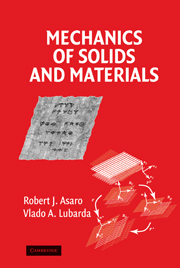Book contents
- Frontmatter
- Contents
- Preface
- PART 1 MATHEMATICAL PRELIMINARIES
- PART 2 CONTINUUM MECHANICS
- PART 3 LINEAR ELASTICITY
- PART 4 MICROMECHANICS
- 17 Dislocations and Cracks: Elementary Treatment
- 18 Dislocations in Anisotropic Media
- 19 Cracks in Anisotropic Media
- 20 The Inclusion Problem
- 21 Forces and Energy in Elastic Systems
- 22 Micropolar Elasticity
- PART 5 THIN FILMS AND INTERFACES
- PART 6 PLASTICITY AND VISCOPLASTICITY
- PART 7 BIOMECHANICS
- PART 8 SOLVED PROBLEMS
- Bibliography
- Index
20 - The Inclusion Problem
Published online by Cambridge University Press: 06 July 2010
- Frontmatter
- Contents
- Preface
- PART 1 MATHEMATICAL PRELIMINARIES
- PART 2 CONTINUUM MECHANICS
- PART 3 LINEAR ELASTICITY
- PART 4 MICROMECHANICS
- 17 Dislocations and Cracks: Elementary Treatment
- 18 Dislocations in Anisotropic Media
- 19 Cracks in Anisotropic Media
- 20 The Inclusion Problem
- 21 Forces and Energy in Elastic Systems
- 22 Micropolar Elasticity
- PART 5 THIN FILMS AND INTERFACES
- PART 6 PLASTICITY AND VISCOPLASTICITY
- PART 7 BIOMECHANICS
- PART 8 SOLVED PROBLEMS
- Bibliography
- Index
Summary
The problem considered here has found application to a legion of physical applications including, inter alia, the theory of solid state phase transformations where the transformation (arising from second phase precipitation, allotropic transition, or uptake of solutes, or changes in chemical stoichiometry) causes a change in size and/or shape of the transformed, included, region; differences in thermal expansion of an included region and its surrounding matrix, which in turn causes incompatible thermal strains between the two; and, perhaps surprisingly, the concentrated stress and strain fields that develop around included regions that have different elastic modulus from those of their surrounding matrices. For the reason that the results of this analysis have application to such a wide variety of problem areas, and because the solution approach we adopt has heuristic value, we devote this chapter to the inclusion problem.
The Problem
In an infinitely extended elastic medium, a region – the “inclusion” – undergoes what would have been a stress free strain. Call this strain the “transformation strain,”eT. Due to the elastic constraint of the medium, i.e., the matrix, there are internal stresses and elastic strains. What is this resulting elastic field and what are its characteristics? In particular, can an exact solution be found for this involved elastic field? The region of interest is shown in Fig. 20.1 and is denoted as VI; the outward pointing unit normal to VI is n.
- Type
- Chapter
- Information
- Mechanics of Solids and Materials , pp. 335 - 354Publisher: Cambridge University PressPrint publication year: 2006



